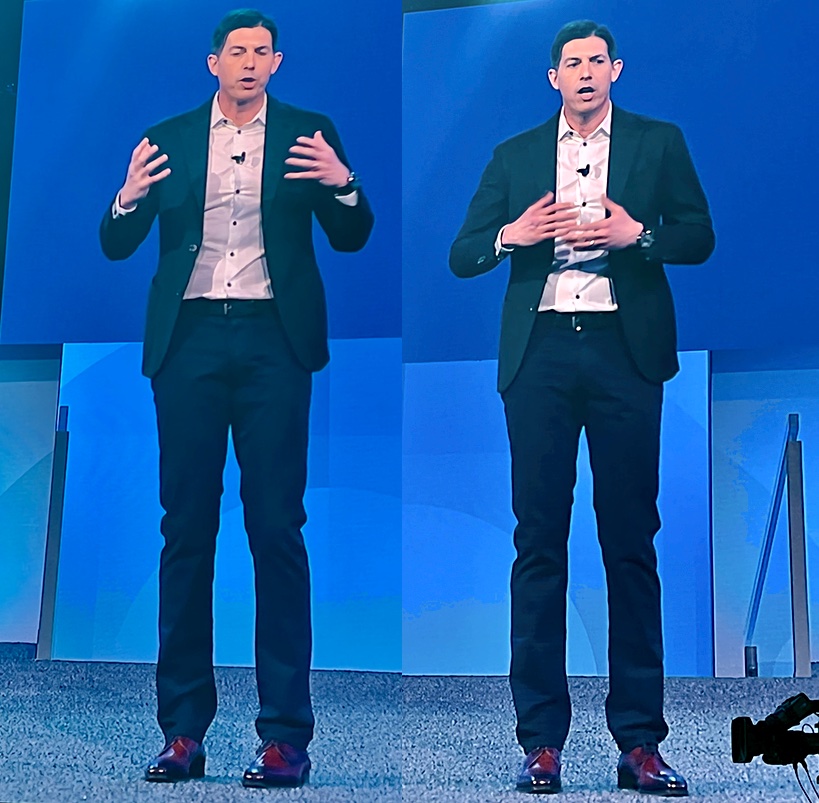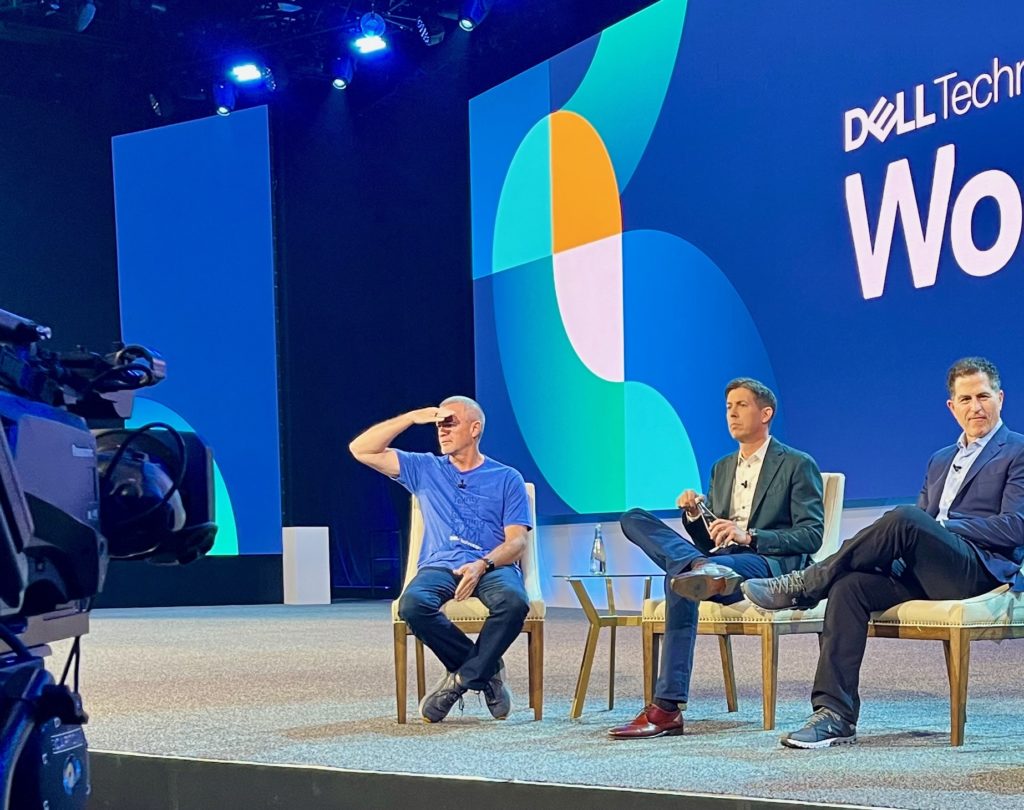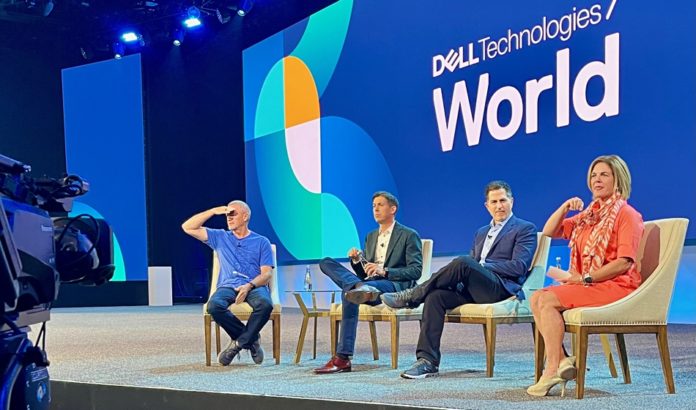Dell Technologies World 2022 attendees this week saw and heard from Dell’s probable next CEO: Chuck Whitten, He arrived at Dell as its co-COO in August last year, a man who had risen without apparent public trace. Who is he?
The Bain guy
Anthony Charles “Chuck” Whitten was educated Texas’s Rice University, a near-Ivy League institution, and then took his mathematical economics and history qualifications to Bain, the business consultancy group, in 1998. Between 2002 and 2004, while at Bain, he did an MBA course at Harvard Business School. And then he carried on at Bain, for a grand total of 23 years and two months, until joining Dell in August 2021.
It’s in the nature of Bain’s consultancy work that its activities are rarely public. But we know that he became a Bain Partner and ended up running Bain’s Southwest division as a managing partner. He was on the Bain Executive Committee for the Americas, and joined Bain’s board of directors in 2018. According to Bain’s website, Whitten worked on growth strategy, complexity reduction, cost optimization and capital markets strategy and was involved in projects looking at hardware, software, solutions and services market segments.
Whitten focussed exclusively on the technology sector since 2011 and worked with Dell – a Bain client – to help shape its strategy and growth initiatives.
Jeff Clarke told Silicon Angle that Whitten had been a top Dell adviser, “an integral part of the team for a long time working across strategy, transformation and operations.”
Whitten is thanked by Michael Dell in his Play Nice But Win book, but as one name amongst 20 to 30 others. There are no clues in that book as to what Whitten accomplished at Bain while advising Dell.

Whitten joined Dell to lead its next phase of growth along with co-COO Jeff Clarke and Chairman/CEO Michael Dell, whose appointment quote said: “As our top advisor, Chuck has been an integral part of the team for a long time working across strategy, transformation and operations. I couldn’t be happier to have him as co-COO to capture big growth opportunities across our portfolio as the world becomes more digital and data-driven.”
Dell said: “Chuck’s leadership, energy, knowledge and humanity make him the obvious choice to join our team and strengthen our industry leadership.” People I spoke to echoed the humanity aspect of this, saying Whitten was a kind man, as well as being whip smart.
But Whitten had no hands-on operational business experience when he joined Dell. He is a strategy consultant and, we think, joined Dell to get the operational experience needed to see if he could step in to Michael Dell’s shoes when Dell decides to retire from being CEO. He needs to earn his spurs so that he can command the confidence of the top Dell exec team. Otherwise he is lost. That’s why he needs – really needs – Jeff Clarke’s mentorship.
Speechifying
His part in the day one keynote was pretty near flawless. We knew his text was presented on low-level monitors in front of him but, even so, it sounded spontaneous and genuine, and yet he can’t have presented to a near 10,000 person audience before. He was exceptionally gracious to Jeff Clarke, the previous Dell COO and now co-COO, saying he was “my mentor” and “an engineer’s engineer”. High praise from the man who may well step into Michael Dell’s CEO shoes in the next 12–18 months, and maybe compensation for Clarke not being that successor.
Still, Clarke looked at ease, as an exec round table picture shows – in t-shirt, casual trousers and trainers;

Whitten’s pitch was competent and assured, moving about the stage and using his hands well. He talked the big picture: “Our purpose is to create technologies that drive human progress”. And he related Dell’s various product and services to that, such as helping health initiatives in India. He sang off the multi-cloud hymn sheet too: “The world needs multi-cloud by design, not by default.”
The shape Dell is in
Dell’s situation in the market is excellent. It announced a great raft of hardware and software updates across its storage portfolio (PowerMax, PowerStore, PowerScale and PowerFlex systems) at the Las Vegas event, enhanced its APEX as-a-service offer with a data protection service and added to its services in AWS and Azure. We mustn’t forget it also demonstrated progress with its Project Alpine initiative to port its file, block and object storage services to the public clouds.
The depth, speed and breadth of this hardware and software engineering work is amazing. No other company could have pulled this off – not IBM, nor HPE nor NetApp. Indeed two of these main competitors look weak and the third limited.
Competing
IBM has sold off its PC and mainstream x86 server product lines and is now more of a Dell partner than a competitor. HPE has sold off its PCs and its storage line looks insubstantial compared to Dell’s portfolio. It has strength in supercomputing – thanks Cray – and its GreenLake as-a-service business model is progressing. But its ability to port its file, block and object storage services to the public cloud is severely constrained, not least by it partnering with other suppliers for file and block storage.
NetApp is a strong storage competitor and has a great CloudOps advantage, albeit in an early-stage market. But NetApp is a pretty much pure-play storage company with no PCs, no servers and no networking. This portfolio breadth gives Dell two substantial advantages: It can sell PCs, servers, storage and network switches to small/medium enterprises through partners and systems and integrated bundles of its components to enterprises. NetApp can’t do this. HPE can do more than NetApp, but not as much as Dell.
Look at their revenue history – the big picture is obvious:

Dell has grown since IBM’s FY2016. IBM has declined. HPE is slightly down, and NetApp, at this scale, is flatlining at low level. Dell reigns supreme.
In fact, Dell is probably in the best shape it’s ever been in. Its product engineers are firing out products and services at great speed as it responds to the hybrid multi-public cloud IT environment that is spreading like a wildfire. Michael Dell said: “The on-prem, off-prem debate is over. The future is multi-cloud.”
Dell’s edge
Data gravity is its friend as on-premises data lakes are large enough for public cloud compute to come; witness the Dell-Snowflake deal. Anti-lock-in is its friend too, as enterprises generally refuse to go all-in for one public cloud. That means data and app portability is a major concern and it’s working in that area.
It is positioned well for the coming world of super edge computing, with telco 5G end-points becoming mini datacenters generating huge amounts of data to be processed locally and with subsets trickled up to central sites – on-premises or public cloud – for collective analysis. Again, Dell summed it up: “The edge is the next frontier where data becomes the competitive advantage at the point of creation. … By 2025 75 per cent of data will be processed outside the datacenter.”
Dell wants to store that data, process that data and send it wherever it’s needed. Myriad 5G edge sites could drive Dell revenues towards the $50 billion level – and if Whitten helps achieve that then Michael Dell’s shoes are there for the taking.








